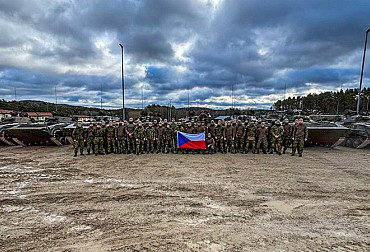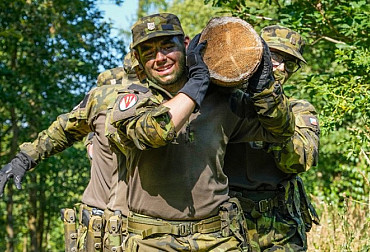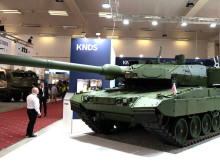Aviators are preparing to Baltic Air Policing again
Nowadays preparation of tens of soldiers for an abroad mission is culminating on the 21st Tactic Aviation Base in Čáslav. “Since the beginning of the year, we have been preparing personnel that meets all criteria starting from excellent health conditions up to language skills. Our target is that from September 2019 the 3rd Baltic Air Policing 2019 Task Force of the Czech Army will start its activity from the Estonian Ämari Aviation Base,“ announces Task Force commander Lieutenant-Colonel Pavel Pavlík. The Task Force is part of the NATO mission for the protection of the airspace of the Baltic countries, which don’t have their own supersonic aviation.

Picture: The Czech fighters will guard the airspace of the Baltic countries again | Tomáš Soušek, army.cz
The aim of the Czech fighters will be to keep combat duty within the NATINAMDS (NATO Integrated Air and Missile Defence System) with help of the JAS-39C Gripen aircraft. We, thus, will participate in keeping the integrity and safety of the Alliance airspace.
“Guarding of the Baltic countries airspace means fulfilment of our allied obligation and a proof that we are a valid and active member of the North Atlantic Alliance,“ said the Minister of Defence of the Czech Republic Lubomír Metnar about the mission.
In performing tasks, the pilots of the supersonic Gripens are allowed to act against aircraft, which don’t observe the specified rules of the international aviation operation. The Czech contingent will cooperate within this task on Baltic with the Danish and Belgium aviation. The above-mentioned countries will act with the F-16 aircraft from the Lithuanian base in Šiauliai.

Picture: For the protection of the Lithuanian, Latvian and Estonian airspace, the Czech Republic is going to send four JAS-39 Gripen planes, and a fifth plane as a reserve | Tomáš Soušek, army.cz
“This is a sixth mission of our fighters. We have already protected the Baltic airspace two times earlier. We got involved in the common protection of the Alliance airspace together with the integration into NATO. We have been continually guarding the Czech Republic airspace for twenty years. I am sure that we will repeatedly manage combat deployment both at home and abroad,“ noted Czech Republic Air Forces Commander Major-General Petr Hromek.
We guard the airspace of allies for the sixth time
The Čáslav Gripens have guarded the Latvian, Lithuanian and Estonian airspace two times so far. We operated in 2009 and 2012 from the Šiauliai Aviation Base. The Czech fighters later guarded the airspace of Island in 2014, 2015 and 2016.
Based on the mandate of the Parliament of the Czech Republic, five Gripens and at the most 95 soldiers mostly from the Časlav Base will be sent to Estonia. On 1st September 2019, it is planned to handover the operation task specified by the Command of the Common Multi-National Operation Centre of NATO from the members of the Royal Air Force (RAF) of the British Armed Forces. It is considered that the task will continue until 31st December 2019, when the Czechs will be interchanged by the other Alliance member. The return of the contingent is planned immediately after the finish of the task, i.e. during the first or second week of January 2020. During the mission, two rotations will be interchanged in the Estonian Aviation Base, when certain part of the personnel will be interchanged in the half of mission.

Picture: It is the third mission of the Gripen pilots on Baltic; they acted in 2009 and 2012 from the Lithuanian Šiauliai Base | Tomáš Soušek, army.cz
An experienced fighting pilot from the Časlav Base, 42-year-old Lieutenant-Colonel Pavel Pavlík was appointed as Commander of the Task Force. By now, he has flown about 1000 fly hours on the JAS-39 Gripen aircraft, and in the past participated in airspace protection within an abroad operation.
The plane will be equipped with standard armament used within the air duty in the Czech Republic. The armament includes guided missiles, an inbuilt cannon and misleading targets of infra-red spectrum, so called flares. A novelty in the current abroad deployment will be the use of the aimed and surveying Litening 4i containers. Although primarily it is a tool which enables precise performance of a stroke at ground targets, it will be used within so called QRA (Quick Reaction Alert) duty for the improvement of ability of remote visual surveillance of aircraft during the day and at night.

Picture: Together with flights of the Czech fighters from the Estonian Ämari Base, the Šiauliai Aviation Base will provide a background for the Danish and Belgium F-16 fighters | Tomáš Soušek, army.cz
Similarly, as in case of deployment in Island, the Gripen pilots will use special equipment, such as, for example, neoprene cloth in case they need to leave the plane and fall into cold water.





















